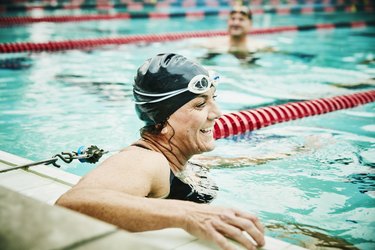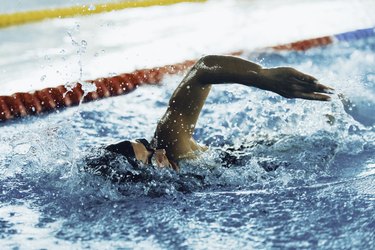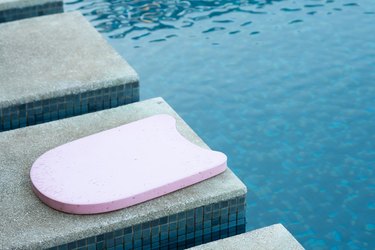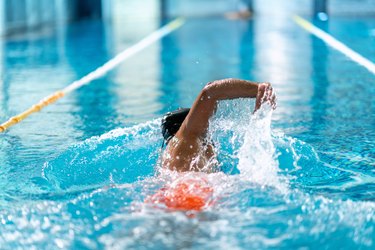
If you want a total-body workout that is easy on the mind and joints, try swimming. No matter your age, body type or fitness level, swimming has tons of benefits that make it an excellent addition to a healthy lifestyle.
Getting started with a swim regimen can be intimidating: What do I do once I get to the pool? What if my swim stroke isn't perfect? How can I make sure I'm getting a good workout? But don't let that hold you back from trying a truly great form of exercise.
Video of the Day
"The goal of swimming is not to fit you into a specific mold," says Gemma Hollis, founder and owner of Push Glide Kick. "Adult swimmers come with a variety of physical and mental backgrounds that will impact who they are as swimmers, and that's OK. There is no one right way to swim."
The high-resistance, low-impact nature of swimming means that your muscles (those that make up your core, back and legs) get a thorough workout without straining your joints. And it's a great time for a mental reset, too.
When swimming, your senses of smell, hearing and even sight may become less useful or slightly distorted. Instead, you become reliant on proprioception, or knowing where your body is in space, and can focus on the feel of the water on your body. Leaning into these sensations can be a great opportunity to get in touch with yourself and give your mind a rest.
Hollis notes many beginner swimmers arrive at the pool and immediately expect to be crushing laps and setting personal bests, but this shouldn't be the focus.
"The goal for a beginner swimmer should be getting them comfortable in the water," Hollis says. "We do that by first gaining experience with breathing, establishing proper body position and then graduating to laps."
Hollis, who coaches swimmers of all levels — such as those who have never put their face in the water or those trying to qualify for the Olympics — gave us the lowdown on how to be confident and comfortable in the pool, and get a great beginner swim workout in 30 minutes. Let's dive in.
Related Reading
1. Breath Work
To get started in the pool, it is essential to be comfortable with having your entire body immersed in water without holding your breath. This exercise aims to get you comfortable with putting your face in the water and exhaling.
- Stand vertically in a shallow part of the pool. Relax your body and breathe naturally.
- Take a deep breath and gently sink down into the pool by bending your legs and allowing your head to become submerged.
- With your head and body still submerged, begin letting out a controlled stream of air from your mouth. Keep your lips slightly pursed and exhale the air through the mouth until your lungs feel comfortably empty and ready to inhale.
- Use your quads, glutes and core to push off the floor of the pool.
- Once your head is above the water, inhale, pause and repeat the exercise 10 to 15 more times depending on your comfort level with putting your face in the water.
2. Kick Drill
Another key aspect of swimming, especially for beginner swimmers, is kicking. In swimming, kicking should "come from your core," meaning your core should remain tight and slightly contracted, which will help your kick be strong. If you don't use your core, your low back will arch and your legs will literally sink down in the water, making kicking extremely difficult.
- Sit on a step in the shallow area of the pool.
- Sit with good posture: a relaxed but straight back, relaxed shoulders and breathing naturally.
- Extend your legs straight out in front of you. As you do this, feel your core and glutes tighten to prevent your low back from arching. Maintain this activation during the entire exercise.
- Keep a bit of slack in your legs as they are outstretched near the surface of the water. You want your legs to be straight, but not immobile.
- Begin kicking with your toes pointing as straight as they can toward the other end of the pool. Maintain activation in the core and glutes — no arching your low back!
- Kick for anywhere from 30 to 60 seconds. Take a brief break.
- Repeat this exercise 10 to 15 times to get the muscle activation and movements committed to memory.
3. Body Position Drill
Once you're comfortable with exhaling in a controlled way underwater and using your core to kick, it's time to move on to establishing good body position in the water. Your goal is to be streamlined, with your core and glutes engaged.
- Stand vertically in a shallow part of the pool. Relax your body and breathe naturally.
- While continuing to breathe naturally, raise your arms overhead, layering one hand over the other to create a “spear” with your hands.
- Think about tightening your core and glutes as you do this, and don't arch your low back. Keep your shoulders relaxed and not artificially scrunched up — they should remain at the level of your jaw and not be bunched near your ears.
- Draw your shoulder blades down by contracting your lats. Don’t forget to keep your core and glutes engaged to avoid arching your low back.
- Hold this position for a few seconds, getting in touch with all the muscles that are activated, then release.
- Repeat this exercise 10 to 15 more times to get a sense for the correct upper-body position for swimming.
4. Push Off Drill
Next, it's time to start putting the above three skills (breathing, kicking and holding proper body position) together horizontally.
- Stand with your back close to the pool wall at the start of the lane.
- Crouch down using your core and glutes to stabilize you.
- Place your hands in that “spear” shape in front of you and under the water. Feel your lats contract to hold your arms out.
- Let your neck relax and your head hang just above the surface of the water — you'll submerge your head in a second. Take a deep inhale.
- In one fluid movement, move from a crouch to pushing off the wall, feeling your glutes and core tighten as you push your body forward. Leverage your lats to hold your arms in front of you the entire time in the “spear” shape.
- As you streamline forward, keep your head submerged and exhale into the water through pursed lips. Kick your legs and use your core to prevent an arched low back.
- As the momentum of the propulsion dies down, become vertical again and water walk back to the start of the lane. Use your core, glutes and calves to maintain strong posture while water walking back to the start of the lane.
- Repeat the exercise 10 to 15 times depending on your comfort level.
5. Execute a Swim Stroke
Now it's time to put all of these skills together into a swim stroke. Most pools are 25 yards or 25 meters from the start of the lane to the other end of the lane. Swimming can be deceptively difficult, so if you're a beginner swimmer, stick to starting with swimming 25-yard repeats. If that feels easy, you can aim for more distance.
- Repeat the motion of pushing off the wall with good form, exhaling as you go. Use your legs to make the same kicking motion in the skills exercise. Keep your core, glutes and lats activated during the push off.
- Now, as the propulsion from the push begins to slow, slightly rotate your body to one side using your core, while one arm uses its lat and triceps to pull through the water, under the water.
- As you rotate to the side, your mouth will be exposed to the air and free to take a breath. Inhale fully through your mouth. You won’t get in enough air if you try to inhale through solely the nose.
- As the arm that is pulling extends back along the body, feel your body’s natural inclination to rotate back toward the center. Exhale as your body returns to a centered position and your face rotates back into the water. Pull in the same motion with your other arm under the water as you exhale.
- Repeat this “one arm, breathe,” “one arm, exhale” pattern until you reach the end of the lane. Pause at the end of the lane to catch your breath.
6. Lap Workout
There are a variety of workouts you can do, but after completing the skills warm-up, you may want to try a workout like this:
- 4 x 25 yards focusing on engaging your core and glutes while rotating with 45 seconds of rest at each wall of the lane
- 4 x 25 yards focusing on exhaling in a controlled manner, then rotating and inhaling in a controlled manner with 45 seconds of rest at each wall of the lane
- 4 x 25 yards with each 25-yard lap slightly faster than the last. Rest for 90 seconds at each wall of the lane
- 4 x 25 yards with breath work. Sink down and exhale at the start of each 25-yard lap (just like in the skills exercise), then resurface, inhale and push off into a steady-paced 25-yard lap. Rest for 45 seconds at the end of each lane.
Cool down with a few more repetitions of each skill exercise to reinforce good form. You can also incorporate water walking in the cooldown to focus on firing up your core, glutes and calves.
As you progress through swimming, you can increase the distance and intensity of your workouts. Start slowly and remember: Swimming is a skill and it takes time to learn. Be patient with yourself and remember that every time you complete a workout in the pool, you're doing wonders for your mind and body.


